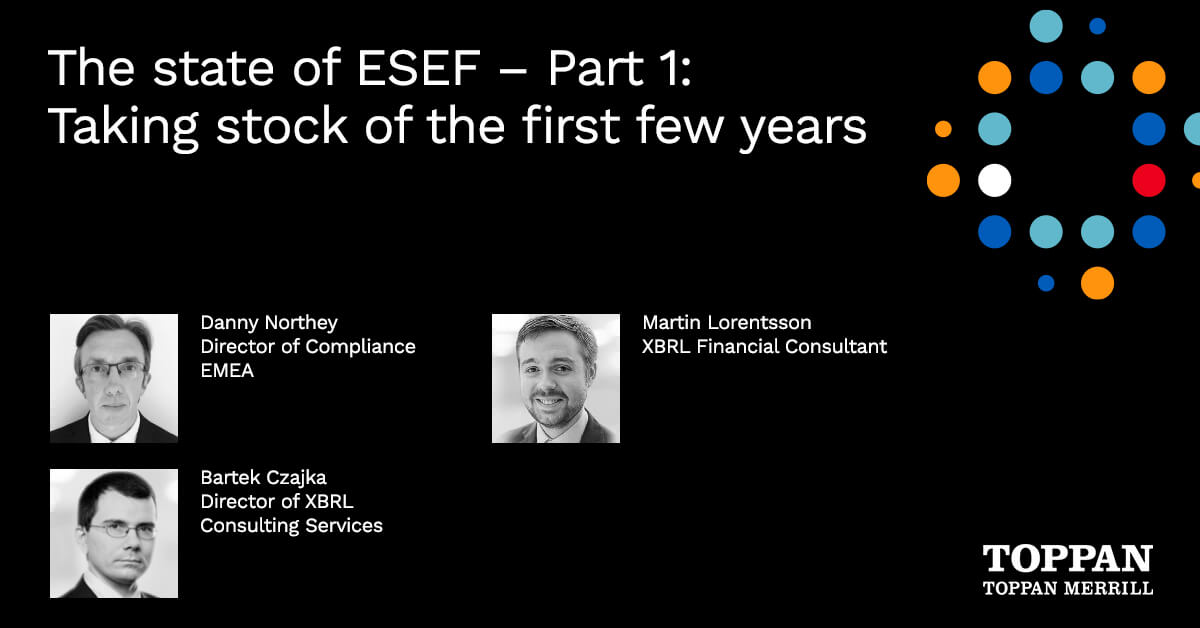After implementing iXBRL tagging of face financials last year as part of the initial requirements of the ESMA ESEF mandate, we are now at the final phase-in requirement: text block tagging. The good news is most issuers now have a baseline understanding of XBRL tagging. But the reality is that block tagging will be challenging and time-consuming, particularly in this first year, because it is far more subjective and nuanced than tagging primary financial statements.
At Toppan Merrill, we are hearing a lot of questions and uncertainties swirling around this final ESEF iXBRL requirement – and in a recent poll we conducted, roughly half of the issuers said they have not started block tagging yet. So, I recently hosted a webinar with Danny Northey, Toppan Merrill’s Director of Compliance for EMEA, covering what issuers need to know now about block tagging.
Here’s a recap of some of the key points we covered:
What is the ESEF iXBRL block tagging requirement?
I co-authored a block tagging 101 blog a few months ago that is a great starting point on the basics of text block tagging. But the best way to describe text block tagging is it is like taking a picture of a section of your financials. Just like all XBRL tagging, you are marking up pieces of information in your company’s financial statements – but in this case, you are marking up entire blocks of content, not individual numerical information within those blocks.
The text block tagging requirement applies to all issuers that tagged consolidated financial statements last year. In other words, if you applied XBRL last year, you will need to also apply block tagging this year. It is also important to note issuers need to block tag information within the notes – not just in the primary financial statements.
Block tagging is more complicated – and requires human validation
With in-line tagging of primary financial statements, 99% of the time, there is a clear right and wrong decision about the tag to use. Text block tagging is much more subjective. Issuers need to work with their auditor and service provider to agree on the appropriate content for each text block tag. This generally takes quite a bit of back-and-forth discussion, and it is a lot easier if you have deep knowledge of both the tags and your financials (more on that later).
This naturally presents another big difference when it comes to validation of in-line tagging of primary financial statements and numerical elements versus validating the text block tagging: I won’t dive into the technical details, but the takeaway is it is almost impossible for validation software to validate that the content of a text block tag is appropriate. It is a human-driven process to make sure the content of the text block is what it is supposed to be. This will first be the job of the preparers and then the auditors. But if you are counting on software to do validation for you (or being told by a vendor it can) you are in for an unpleasant surprise.
You should start preparing now
Timing is always critical in financial reporting. Work gets bunched up and timelines get crunched at the very end of the process. Preparing ahead of time can make a huge difference in “crunch time.” We saw last year those who did initial mapping before they tagged their financials saved time in the end and likely had a lot less stress in the process.
It is a similar story here: If you start the text block tagging process early, you will find it a lot easier at the end of the process. Moreover, issuers should plan for the text block tagging process to take longer than they might expect – both because it is year one, and because it is subjective and multiple parties will have to agree on tag selection.
The ESEF block tagging requirement also is very different from the requirements of the SEC. For the SEC requirements, you start with your financials – so you are looking at your notes and accounting policies and finding an appropriate block tag. With the ESEF requirement, you will actually start with the tag – then try to find the appropriate information to tag within your financials. If you have experience in the U.S., you should expect the ESEF process to be much more time-consuming.
Start by getting to know the tags
The latest ESEF Regulatory Technical Standards (RTS) include more than 250 text block tags. The ESMA ESEF Reporting Manual provides guidance on how to approach block tagging, how to use various tags, as well as some of the nuances. It’s also a good idea to come back to this ESMA guidance once you are done block tagging to make sure you are in line.
So, do you need to use all 250+ block tags? No. The number of tags you use will depend on the size of your financial statements and how many topics are covered. Some of the tags are general and nearly every entity will use them. Others are very specific. The best practice is to start by going through the full list of text block tags to identify the tags that do not apply to your company. For reference, the clients I’m working with are typically using about half of the tags (100-130).
The better you know your financials, the easier this will be
Once you have culled your list of relevant tags from the full list, the best practice is to go one by one through that list to figure out which information matches each relevant text block tag. I cannot stress this enough: Knowledge of your financials is key. If you don’t know your financials well, you are going to struggle to find the information that relates to the text block tags.
Correcting common misconceptions
In the webinar, we went through specific examples to address some misconceptions we have encountered:
- Notes cannot have more than one tag: Many people have the mistaken impression block tagging is one-to-one – you have one note and you apply one tag. But the ESEF requirement says you actually start with the tag and then find the appropriate information. In the webinar, I walked through an example where one note has four tags that apply to it. The larger point is that just because a piece of information is already tagged, it does not mean it shouldn’t be considered for other tags.
- One tag cannot combine multiple notes: On the opposite side of the point above, many assume an entire note is the largest piece of content that should be tagged with one tag. This misconception is especially common among those with experience with the SEC block tagging requirements. With ESEF, you are starting with the tag and then finding (all) appropriate information. That means one tag can combine two (or more) different notes.
- Tags cannot be applied to specific text within a note: One note is not the biggest unit of content that can be tagged, but one note also is not the smallest unit of content that can be tagged. In the webinar, I showed an example where you need to go inside a note to find the specific information that applies to a tag.
Once again, the bottom line here is deep knowledge of your financials – so you know where content exists within notes – is critical to making sure you are tagging everything you should.
An experienced partner can be a shortcut
If this feels like a lot to learn – on top of juggling all the other responsibilities around financial reporting – you are not wrong. Here at Toppan Merrill, we have been helping hundreds of issuers begin the block tagging process, and it has demonstrated a couple of key ways that leaning on an experienced service partner can be a big help – both for this first year of the new requirement and in the years to come to stay current with rule changes and taxonomy updates.
- Experience = time savings: An experienced service provider should be able to come in on Day 1 with detailed knowledge of all the 250+ text block tags in the ESEF Taxonomy, and how/where to apply them. That knowledge means significant time-savings for issuers in the block tagging process.
- Experience = quality: Time is the big focus, but issuers cannot lose sight of the importance of XBRL quality. As I have said several times already, block tagging involves a high degree of human judgment. Leading service providers can draw on their experience to confidently guide that judgment and establish precedents which protect XBRL quality going forward.
- Experience = better communication: Because of the subjectivity of block tagging, there will be a lot of back-and-forth between the issuer, the service provider and the auditor. From our current experience with clients that have already started the block tagging process, this discussion is more expansive than most expect. An experienced service provider can use the information they have gleaned from other issuers and other jurisdictions to provide clearer communication and guide the better, more productive discussion.
What’s next for ESEF XBRL requirements?
Text block tagging is the last phase-in requirement of the original ESMA ESEF mandate, and there is nothing currently planned. But what could come next? In the webinar, Danny and I shared our thoughts on the future of ESEF, focusing on two main directions that ESMA could go:
- Detailed tagging of numerical values in the notes: The SEC requirement involves tagging each and every financial number in your financial statements – a huge number of tags. Personally, I do not think ESMA will go all the way there. But I do know that users/consumers of data want more detailed information from the tagging. There is a high likelihood the information in the notes will not be enough for users when they are block tagged and users will push for detailed tagging of more areas.
- Adding a half-yearly tagging requirement: Something I see more likely is the addition of a half-yearly tagging requirement. The good news is this would not mean much more work for issuers. If you have already tagged the notes with the text blocks in your annual reports, taking that from the annual report to the half-yearly report should not be an overly difficult or time-consuming task. I think half-yearly tagging is a natural extension we can expect, perhaps even in the next few years. The overarching theme here is the demand for more data. Users (analysts, investors, etc.) want more data, and data that comes in more frequently is more usable.
We covered a lot of ground in the webinar. I went deeper into specific examples and we finished with a lively Q&A that brought out some really great questions. The full webinar is now available on-demand, and I encourage you to check it out when you have time.
Toppan Merrill is here to help.
Based across Europe, the dedicated XBRL trained and certified team at Toppan Merrill has worked with numerous companies throughout EMEA to confidently prepare and submit their annual reports. Visit our ESEF Reporting page to learn more – or connect with one of our experts at [email protected] or by calling +44 20.7422.6100.



